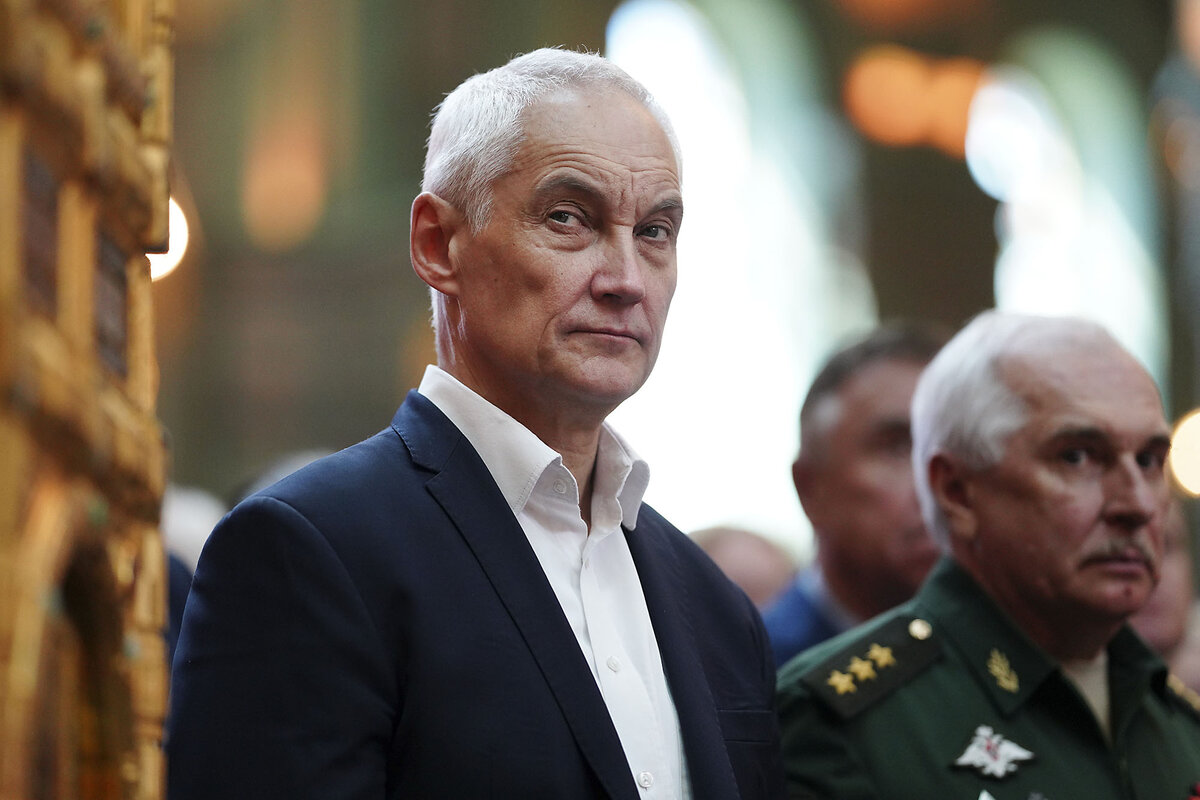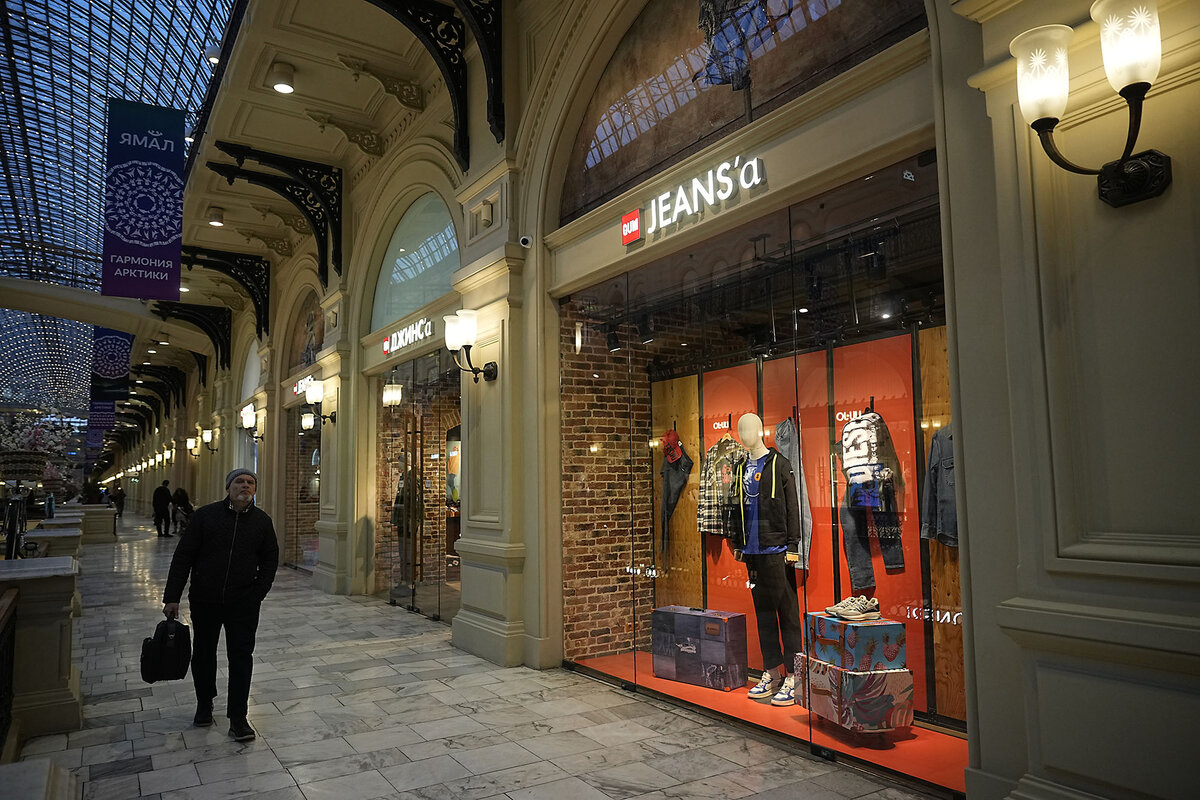The Kremlin is all-in on war in Ukraine. That includes transforming Russia’s economy.
Loading...
| Moscow
Despite Western sanctions, Russia’s economy is back at a level that outproduces the entire West in some key military goods. And the Kremlin appears to be committed to a war economy for the long haul.
Though Russia’s gross domestic product shrank by 1.2% in 2022, it grew by 3.6% the next year and is expected to expand by as much as 5% this year. Experts say that growth is being driven by military expenditures, which have ballooned from about $75 billion before the war to almost $400 billion this year.
Why We Wrote This
A story focused onDespite an unprecedented array of Western sanctions, Russia has persevered, even prospered. Now the Kremlin appears to be consolidating its economy fully toward the waging of war in Ukraine.
To manage the tsunami of new money into Russia’s military machine, Mr. Putin recently replaced Sergei Shoigu with economist Andrei Belousov.
Analysts say that Mr. Belousov will attempt to implement a U.S.-style “military Keynesianism,” in which industry is made to focus on war priorities through the incentive of lucrative state contracts. His task will be to streamline procurement, keep costs down, and induce business to react quickly to changing battlefield requirements.
“The Ministry of Defense has lots of money, but it is spent in strange ways,” says Natalya Zubarevich, an economic geographer. “To make all that money work more effectively, to optimize it, is a very big job.”
Amid its grinding war of attrition and economic mobilization against Ukraine, Russia is changing fast.
As the Defense Ministry spends ever-increasing amounts of money to procure the equipment it needs and to recruit more soldiers, the country’s business environment and economic geography are being reshaped. And the military-industrial complex, which was vastly downsized in post-Soviet years, is reviving quickly.
Confounding observers in many ways, Russia’s war economy, despite Western sanctions, is now back at a level that outproduces the entire West in some key military goods. And the Kremlin appears to be committed to a war economy approach for the long haul, as suggested by the recent reshuffling of Defense Ministry leadership.
Why We Wrote This
A story focused onDespite an unprecedented array of Western sanctions, Russia has persevered, even prospered. Now the Kremlin appears to be consolidating its economy fully toward the waging of war in Ukraine.
Whether such an economic policy is viable is in debate. Optimists say the rapid economic development is economically positive on balance, or at least that Russia can sustain high levels of military spending for the foreseeable future. Pessimists argue that the Kremlin is building a permanent war economy, much like the one that strangled the Soviet Union, and that hopes of building a prosperous consumer economy are fast vanishing. But for the moment, Russian President Vladimir Putin appears all in.
“We have an overheating economy, and it’s changing in some ways. But for now it seems manageable,” says Alexei Vedev, an economist with the Gaidar Institute in Moscow. “If the war ends, as we all hope it will, it will be necessary to reverse some of the structural changes that are happening. We’ll have to seriously tackle inflation. And Russia needs sources of foreign investment,” which have largely dried up with the exodus of Western businesses from Russia.
Russia’s war engine
Many Western observers are belatedly acknowledging that Russia is politically consolidated and unexpectedly resistant to the most intense barrage of sanctions in history. And even while ostracized by the West and its friends, Russia appears to have strengthened its relations with China and many important countries of the Global South.
But most surprising has been the Russian economy’s capacity to field and equip a growing army amid a long, grinding war of attrition, while continuing to provide stable living standards for the population.
Though Russia’s gross domestic product shrank by 1.2% in 2022, it grew by 3.6% the next year and is expected to expand as much as 5% this year. Experts say that much of that growth is being driven by vastly increased military expenditures, which have ballooned from about $75 billion before the war to almost $400 billion this year. Thanks to its ability to continue exporting energy and raw materials, Russia can afford it.
The biggest shock, for many observers, has been the ability of Russia’s economy to rapidly ramp up war production to levels unseen since the Cold War. As recently as five years ago, Russian military spending was actually falling, but Mr. Putin recently said it’s now around 8% of GDP and climbing.
While that has produced inflation of almost 8% and interest rates of up to 20%, it’s also churning out the arms, materiel, and munitions sufficient to keep the Russian armies pressing forward in Ukraine. For example, Russian industry now produces three times more artillery shells than Europe and the United States combined, according to a recent report.
An adaptive economy
To manage the tsunami of new money into Russia’s military machine, Mr. Putin recently replaced his longtime loyal defense minister, Sergei Shoigu, with an economist, Andrei Belousov. Mr. Belousov is reputedly highly competent in matters of finance, but has no known military background.
Analysts say that Mr. Belousov will attempt to implement a policy resembling U.S.-style “military Keynesianism,” in which industry is made to focus on war priorities – not through Soviet-style central planning and command, but with the incentive of lucrative state contracts. His difficult task will be to streamline the process of procurement, keep costs down, and induce business to innovate and react quickly to changing battlefield requirements.
“Belousov supports the idea that the state has to invest into technological development and participate in the modernization of industry,” says Natalya Zubarevich, an economic geographer at Moscow State University. “The Ministry of Defense has lots of money, but it is spent in strange ways. To make all that money work more effectively, to optimize it, is a very big job.”
According to Ms. Zubarevich, some industrial and mining regions that support war production are thriving, while others that rely on exports like coal and gas are hurting while they struggle with disruptions from sanctions. On the whole, because of industrial growth and an acute labor shortage, wages are rising rapidly.
“The population’s incomes were up 16.5% as of January this year,” she says. “Effective demand is up, and new business opportunities are opening up. A lot of wealthy Russians are locked out of the West and have no way to get their money out. So they are investing in Russia. On the whole, for now, the Russian economy seems to be adapting.”
The former Soviet Union spent up to 20% of GDP on the military over a long period. Russian analysts say the country might be able to spend 10% for a few years without becoming bogged down.
“Russia is a market economy, and it’s much more flexible and adaptable than the Soviet one,” says Ms. Zubarevich.
Societal changes to come?
Russia’s ability to recruit up to 30,000 soldiers monthly using economic inducements has enabled it to avoid another forced mobilization like 2022’s emergency drive, which led to serious public disruptions.
It also portends lasting social changes. Russia has a preexisting culture of honoring war veterans, and a new generation of men who served in Ukraine is already being glorified. When the war ends and all these men return to civilian life, they will be expecting a reward.
“At the beginning, participants of the special military operation were being paid about 200,000 rubles [about $2,200], but now payments have grown up to as much as 1 million [about $11,000],” says Ms. Zubarevich. “They and their families are the beneficiaries of this situation,” which has stimulated a housing boom in some regions. “What happens when they return home, what will their future status be? I do not know.”
Andrei Movchan, a Russian financier and former director of the Moscow Carnegie Center who now lives in Britain, says the war has been beneficial for Mr. Putin’s regime, enabling it to consolidate power, eliminate opposition, isolate Russia from the West, and create short-term economic stimulus. But, he says, the long-term price tag will keep growing.
“This situation reminds us of the processes in the Soviet economy in the late ’60s onward, when an increasing share of resources was spent on military purposes, which were given priority over consumer production,” he says. “We are seeing Russia take that road once again.”











